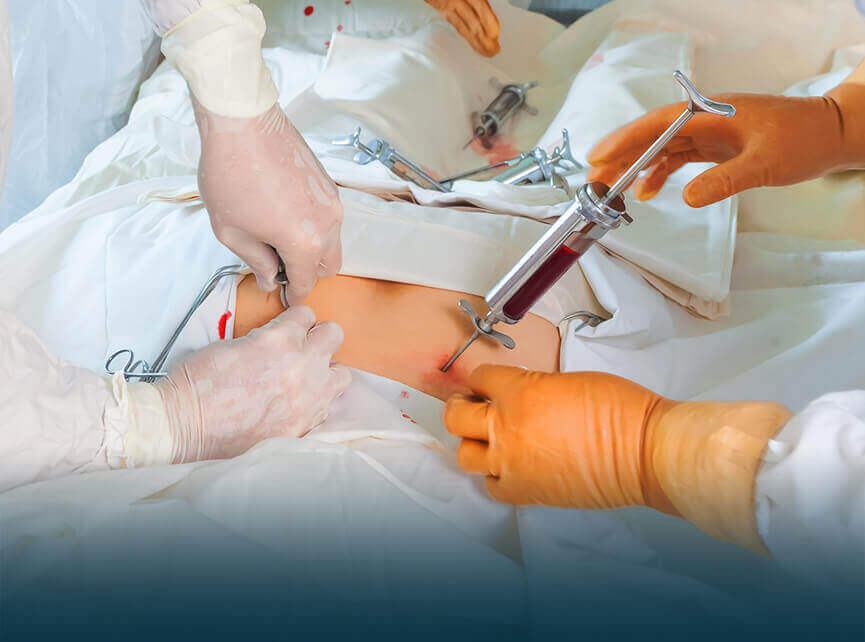Content Attributes
Many problems in the body may arise soon after the bone marrow transplant because the bone marrow wipes out by medicine or radiation just before the transplant. While other problems may be side effects of the treatment. Fret not! Your stem cell transplant team will help you cope with the side effects. Some side effects can be prevented while some can be treated to make you feel better.
In case, of any problems you face after your stem cells transplant, you need to immediately bring it to your doctor’s notice. Some problems may be life-threatening so it’s vital to bring it to your doctor’s notice as soon as you face it.
Healthy bone marrow and blood cells are essential to life. Bone marrow takes donors’ healthy blood cells and puts them into the patient’s bloodstream to make healthy red blood cells, platelets, and white blood cells. Patients receive high levels of chemotherapy to prepare their bodies for the transplant.
The survival rate as of 2019 after bone marrow transplant has improved considerably with more accurate genetic matching with donors, following up transplantation with an antibiotic regimen to control infections, and improved post-transplant care, in general. Apollo hospital is the best Bone Marrow Transplant in India.
Cancer and other types of diseases of the blood and the bone marrow which is responsible for manufacturing blood cells may require a stem cell transplant from a healthy, genetically compatible donor. The deceased cells are replaced with the donor’s marrow to allow the body to maintain healthy levels of red blood cells, platelets, and white blood cells.
What is a bone marrow transplant?
A bone marrow or stem cell transplant is a procedure that infuses healthy blood-forming stem cells into your body to replace your diseased or damaged bone marrow. You might need a stem cell transplant if your bone marrow stops working and does not produce enough healthy blood cells. It usually uses cells from your own body known as an autologous transplant or from a donor known as an allogeneic transplant.
Bone Marrow Transplant Cost ranges from USD 25,000 to USD 40,000 in India.
Reasons for Bone Marrow Transplant
- Provide new stem cells which may kill cancer cells
- Replace damaged or diseased cells with healthy new stem cells
- Safely allow treatment of your condition with high doses of chemotherapy or radiation by replacing the bone marrow damaged by treatment.
Side Effects of Stem Cell or Bone Marrow Transplant:

Mouth and throat pain:
Mucositis or sores in the mouth/inflammation is a short-term side effect that can happen after radiation or chemo. It usually gets better within weeks of treatment but it can be very painful while drinking or eating. Hence, good nutritional food is important for people with cancer.
If sores in the mouth make it hard to swallow, then your bone marrow transplant team will help you develop a plan to manage your symptoms.
Nausea or vomiting:
Chemotherapy drugs can give nausea or vomiting, hence doctors give anti-nausea medicines along with the chemo to try to prevent it. The aim is to prevent nausea or vomiting because it’s easier to prevent rather than to stop it once it starts. Preventive treatments should start before the chemo is given and should continue for as long as the chemo.
No drug can prevent 100% of nausea or vomiting caused by chemotherapy. In many cases, two or more medicines are used. You need to provide feedback to your team on how well the medicines are controlling your nausea or vomiting. If they aren’t working then it needs to be changed.
Infection:
For at least 6 weeks after the stem cell transplant, until the new stem cells start forming white blood cells you can easily get serious infections. Bacterial infections are common during this time but viral infections that were controlled by your immune system can become active again.
Fungal infections can also be an issue here. Infections that may cause mild symptoms in people with normal immune systems can be quite dangerous for you. White blood cells are primary immune cells that fight off infections. But after the transplant, your body will not have enough white blood cells to fight against infections.
Doctors might give you medicine to fight against infections until your blood counts reach a certain level. It’s very important to contact your transplant team if any infection occurs. The most common sign of infection is fever. The team of doctors will conduct tests to see the cause of the infection and thereafter the antibiotics will be prescribed.
Bleeding and transfusions:
After the transplant, you are at risk of bleeding because the conditioning treatment destroys the body’s ability to generate platelets. Platelets are the blood cells that help the blood clot. While you wait for transplanted stem cells to form back, your transplant team may have you follow special precautions to avoid bleeding and transfusions.
Platelet counts are slow after transplant. In the meantime, you may notice nose bleeding or gum bleeding. If your platelet count drops to a certain level, a platelet transfusion may be needed. You’ll need to take precautions until your platelet count reaches the desired level.
It also takes bone marrow to start making red blood cells, you might need certain red blood cell transfusions from time to time as you recover.
Interstitial pneumonitis and other lung problems:
Pneumonitis is a type of swelling in lung tissue that’s most common in the first 100 days after transplant. Some lung problems may take place even two or more years after the transplant. Pneumonia is caused due to infection often, but pneumonitis could be caused by radiation, chemo, or graft versus host disease. It’s caused by damage to the areas between the cells of the lungs known as interstitial spaces.
Pneumonitis can be severe if total body irradiation was given with chemo as part of pre-transplant treatment. Chest X-rays will be taken to keep a check on pneumonitis as well as pneumonia. Some doctors will also do breathing tests every few months if you have graft versus host disease.
If you experience shortness of breath, it’s advisable to convey your doctor right away. There are many other types of lung and breathing problems that need to be handled quickly.
Graft versus host disease (GVHD):
GVHD can happen in allogeneic transplants when the immune cells from the donor see your body as someone else. The donor’s immune cells may attack certain organs, mostly the skin, liver, and gastrointestinal tract. This may change the way the organ works and increase the chances of infection. GVHD is very common and can range from barely noticeable to life-threatening.
Doctors think of GVHD as acute to chronic. Acute GVHD starts after the transplant and lasts for a shorter period of time. While chronic GVHD starts later and may last longer. A person may have one or both or neither type of GVHD.
Hepatic veno-occlusive disease (VOD)
This is a serious problem in which tiny veins and other blood vessels inside the liver become blocked. This isn’t common and may happen with people with allogeneic transplants and in those who got the drugs busulfan or melphalan as part of conditioning, or treatment that was given before the transplant.
This happens usually within 3 weeks of the transplant. It’s common with older people who had liver problems before the transplant. It starts with dark urine, yellowing of skin and eyes, tenderness before the right ribs, and quick weight gain. VOD is life-threatening and hence early diagnosis is vital.
Graft failure:
Graft fails when the body does not accept new stem cells. The stem cells do not go into the bone marrow and multiply as they should. Graft failure is common when the patient and donor are not well matched and when patients get stem cells that have had the T-cells removed.
This may also happen to patients with a lower number of stem cells such as a single umbilical cord unit but it isn’t common. Graft failure may lead to severe bleeding and infection.
Transplant problems that may show up later:
The long-term risks after the transplant include:
- Organ damage
- Relapse
- Secondary cancers
- Abnormal growth of lymph tissues
- Infertility
- Hormonal changes
- Cataracts
Antibiotics can harm the body’s organs such as the lungs, heart, liver, bones, kidneys, and nervous system. You’ll require careful follow-up and regular monitoring.
Bone marrow transplant cost ranges from USD 25,000 to USD 40,000 in India.
The survival rate after stem cell transplant:
BMT in India for patients with nonmalignant diseases has a far better survival rate of 70% to 90% with a matched sibling donor and 36% to 65% with unrelated donors. The survival rates for patients with acute leukemia in remission are 55% to 68% with related donors and 26% to 50% if the donor is unrelated.
Transplants of younger patients have high success rates. When both the donor and recipient are cytomegalovirus (CMV) negative, the survival rates are much higher.
A bone marrow transplant can cure some diseases and put others into remission. The goals of the stem cell transplant depending on the individual’s situation, but it usually includes curing your disease and extending and improving your quality of life.
Some patients will complete bone marrow transplants with side effects and complications. Others may experience short-term or long-term health problems.
We wish you a healthy and prosperous life! The decision lies in your hand.



